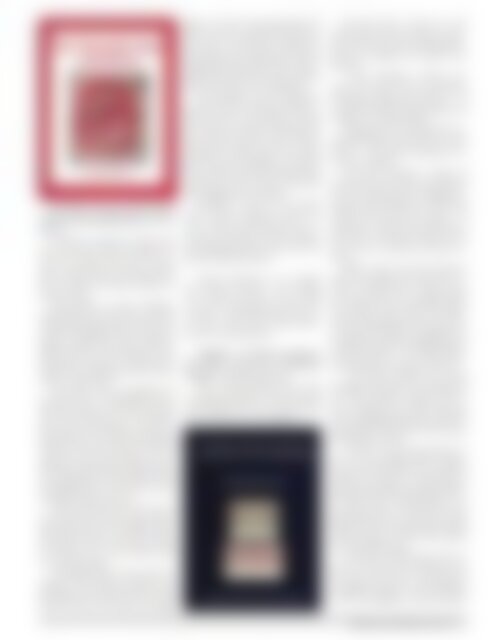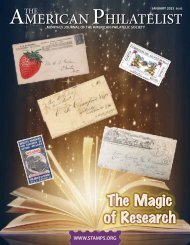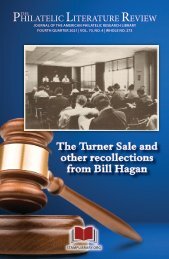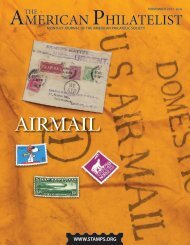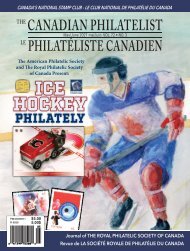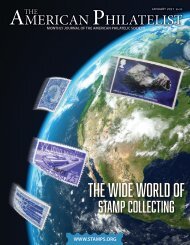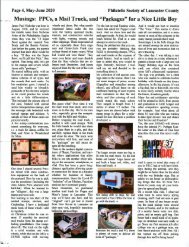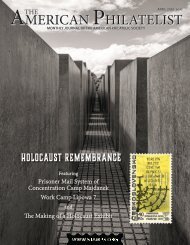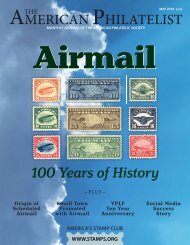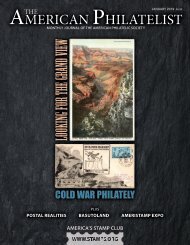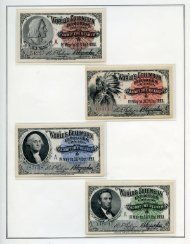February 2018 - Sneak Peek
The American Philatelist is the monthly journal of the American Philatelic Society, the world's largest organization for stamp collectors and enthusiasts. Members receive the printed magazine and can access the digital edition as a benefit of membership in the Society. Please enjoy this sneak peek. We're confident that once you see all that we offer, you'll want to join the APS today.
The American Philatelist is the monthly journal of the American Philatelic Society, the world's largest organization for stamp collectors and enthusiasts. Members receive the printed magazine and can access the digital edition as a benefit of membership in the Society. Please enjoy this sneak peek. We're confident that once you see all that we offer, you'll want to join the APS today.
Create successful ePaper yourself
Turn your PDF publications into a flip-book with our unique Google optimized e-Paper software.
The Thirty-Six Types of fthe Canada<br />
1898 Two Cent Numeral Issue, by Peter<br />
Spencer<br />
If you ever wanted to see how to get<br />
down and dirty with the multiple versions<br />
of a single issue, this is a great<br />
place to obtain an up-close education of<br />
how to analyze the many varieties of a<br />
specific stamp.<br />
Peter Spencer, a native of Alberta,<br />
taught physics for about 30 years before<br />
retiring and finding much more time to<br />
spend as a philatelist. This is Spencer’s<br />
eighth volume on the plating of Canada’s<br />
Queen Victoria-era Numeral Issue<br />
and the third exploring specific aspects<br />
of the 2-cent carmine.<br />
The author “has accomplished the<br />
herculean task of identifying the specific<br />
time periods, over the 64 months<br />
that it was in production, in which different<br />
plates were actually used to print<br />
stamps of this issue,” states the BNAPS<br />
note at the front of the book. “Accomplished<br />
by examining 55,000 dated copies,<br />
sorting them in chronological order<br />
and plating them one by one, it was an<br />
incredible amount of work.”<br />
That work presents the 36 types of<br />
this stamp with text and super-magnified<br />
details that show the different plating<br />
varieties. There is at least one chapter,<br />
maybe more, for the 22 plates used<br />
to create this stamp.<br />
It probably helps to have some familiarity<br />
with printing methods and<br />
plating before diving into this book. But<br />
even for those of us whose eyes might<br />
glaze over when reviewing transfer die<br />
rolls, re-entries, meshes and shift transfers,<br />
there is much here to appreciate.<br />
By offering concise definitions and text<br />
along with massive blow-ups I could actually<br />
follow distinctions such as ghost<br />
dots and evidence of cracked plates.<br />
Even though I am not a flyspecker<br />
and will never try chasing all of the varieties<br />
of this (or any) stamp, I learned<br />
a<br />
lot about our hobby by taking some<br />
time with this intense work. I think I<br />
will grab the single copy of this stamp<br />
that I own, put a magnifier to it and see<br />
if I can detect some of the details found<br />
in Spencer’s work. I know I will be the<br />
better philatelist for the effort.<br />
Published in 2017 by the British<br />
North America Philatelic Society, Ottawa,<br />
Canada. Spiral bound, 8½ by 11<br />
inches, 83 color pages. $49.95 Canadian,<br />
plus shipping; 40 percent discount on the<br />
book for BNAPS members.<br />
BNAPS publications are available<br />
from Sparks Auctions, 1550 Carling<br />
Ave., Suite 202, Ottawa, ON K1Z 8S8,<br />
Canada, or bnaps@sparksauctions.com.<br />
Or, order on the web via http://sparksauctions.com/bnapsbooks.<br />
Baghdad in British Occupation:<br />
The Story of the 1917 Provisional<br />
Stamps, by Freddy Khalastchy<br />
This award-winning book from<br />
a respected member of the esteemed<br />
Royal Philatelic Society London has all<br />
the earmarks of a true champion.<br />
But don’t take it from me, who<br />
knows little of this area. Here is a snippet<br />
from the Foreword, by Philip Kinns,<br />
director of philately for Stanley Gibbons<br />
Ltd.:<br />
“…this handsome volume…represents<br />
the fruits of years of assiduous<br />
collecting, thought and research… To<br />
say that he has done [this period] proud<br />
would be an understatement.”<br />
Kinns goes on to wax about the “lavishly<br />
illustrated record of the surviving<br />
stamps … The variety and range of covers<br />
are a revelation.”<br />
The book examines a group of<br />
stamps that were created out of turmoil<br />
for a very specific locale – Baghdad toward<br />
the end of World War I. The book<br />
explains why and how the stamps – all<br />
overprints – were issued, and presents a<br />
full record of all known stamps, errors<br />
and covers as a reference for future collectors.<br />
History tells us that the Ottoman<br />
Empire controlled much of Iraq for centuries.<br />
In World War I, Turkey joined<br />
the Central Powers and fought against<br />
Great Britain and its allies. The Indian<br />
Army, under guidance from Great Britain,<br />
did much of the heavy lifting in the<br />
campaign through Iraq. Baghdad finally<br />
fell on March 11, 1917 when British<br />
and Indian forces moved into the city.<br />
The British quickly went about<br />
bringing order back to the beleaguered<br />
city. This included creating civil offices,<br />
including a post office. That task<br />
also included gathering unused Turkish<br />
stamps that had not been burned upon<br />
the Ottomans’ retreat.<br />
Sir Percy Cox, the chief political officer<br />
in Iraq, thought that the stamps<br />
would annoy the enemy and would also<br />
indicate the change of administration<br />
whereby the British replaced the defeated<br />
Turks. Much correspondence was<br />
exchanged between Iraq and the India<br />
Office, with the occasional involvement<br />
of King George V, before these stamps<br />
were eventually issued.<br />
In the end, 14,580 stamps of 25 varieties<br />
were found and overprinted for<br />
use (some with errors) as provisionals<br />
in Baghdad, going on sale September<br />
1, 1917, according to a section written<br />
FEBRUARY <strong>2018</strong> / AMERICAN PHILATELIST 171


